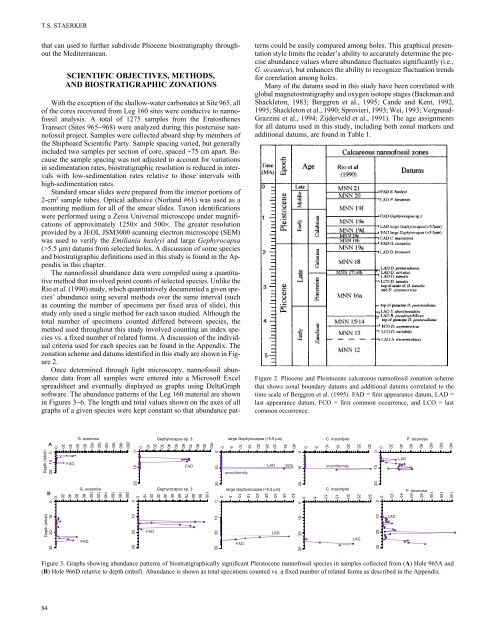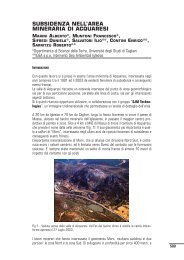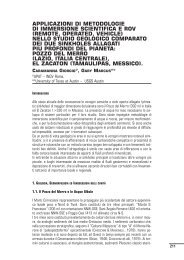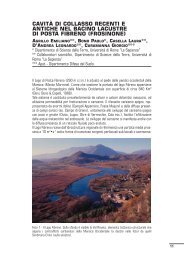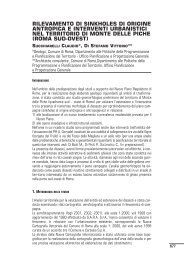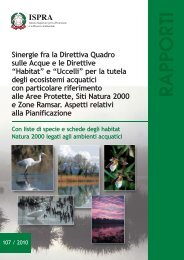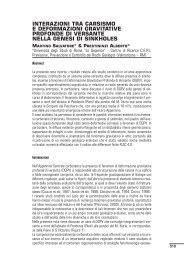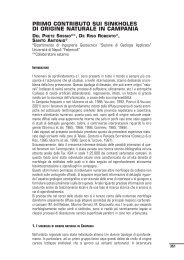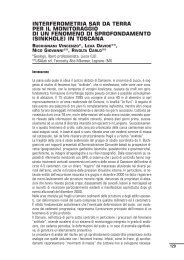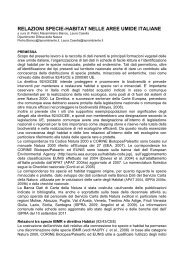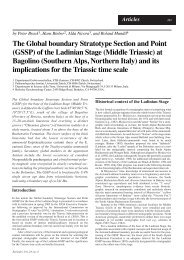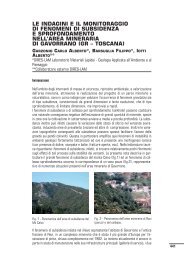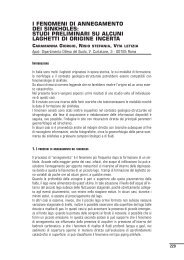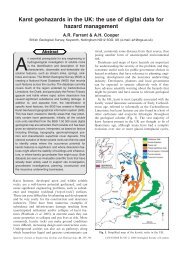7. quantitative calcareous nannofossil biostratigraphy of ... - Ispra
7. quantitative calcareous nannofossil biostratigraphy of ... - Ispra
7. quantitative calcareous nannofossil biostratigraphy of ... - Ispra
You also want an ePaper? Increase the reach of your titles
YUMPU automatically turns print PDFs into web optimized ePapers that Google loves.
T.S. STAERKER<br />
that can used to further subdivide Pliocene <strong>biostratigraphy</strong> throughout<br />
the Mediterranean.<br />
SCIENTIFIC OBJECTIVES, METHODS,<br />
AND BIOSTRATIGRAPHIC ZONATIONS<br />
With the exception <strong>of</strong> the shallow-water carbonates at Site 965, all<br />
<strong>of</strong> the cores recovered from Leg 160 sites were conducive to <strong>nann<strong>of</strong>ossil</strong><br />
analysis. A total <strong>of</strong> 1275 samples from the Eratosthenes<br />
Transect (Sites 965−968) were analyzed during this postcruise <strong>nann<strong>of</strong>ossil</strong><br />
project. Samples were collected aboard ship by members <strong>of</strong><br />
the Shipboard Scientific Party. Sample spacing varied, but generally<br />
included two samples per section <strong>of</strong> core, spaced ~75 cm apart. Because<br />
the sample spacing was not adjusted to account for variations<br />
in sedimentation rates, biostratigraphic resolution is reduced in intervals<br />
with low-sedimentation rates relative to those intervals with<br />
high-sedimentation rates.<br />
Standard smear slides were prepared from the interior portions <strong>of</strong><br />
2-cm 3 sample tubes. Optical adhesive (Norland #61) was used as a<br />
mounting medium for all <strong>of</strong> the smear slides. Taxon identifications<br />
were performed using a Zeiss Universal microscope under magnifications<br />
<strong>of</strong> approximately 1250× and 500×. The greater resolution<br />
provided by a JEOL JSM3000 scanning electron microscope (SEM)<br />
was used to verify the Emiliania huxleyi and large Gephyrocapsa<br />
(>5.5 µm) datums from selected holes. A discussion <strong>of</strong> some species<br />
and biostratigraphic definitions used in this study is found in the Appendix<br />
in this chapter.<br />
The <strong>nann<strong>of</strong>ossil</strong> abundance data were compiled using a <strong>quantitative</strong><br />
method that involved point counts <strong>of</strong> selected species. Unlike the<br />
Rio et al. (1990) study, which <strong>quantitative</strong>ly documented a given species’<br />
abundance using several methods over the same interval (such<br />
as counting the number <strong>of</strong> specimens per fixed area <strong>of</strong> slide), this<br />
study only used a single method for each taxon studied. Although the<br />
total number <strong>of</strong> specimens counted differed between species, the<br />
method used throughout this study involved counting an index species<br />
vs. a fixed number <strong>of</strong> related forms. A discussion <strong>of</strong> the individual<br />
criteria used for each species can be found in the Appendix. The<br />
zonation scheme and datums identified in this study are shown in Figure<br />
2.<br />
Once determined through light microscopy, <strong>nann<strong>of</strong>ossil</strong> abundance<br />
data from all samples were entered into a Micros<strong>of</strong>t Excel<br />
spreadsheet and eventually displayed as graphs using DeltaGraph<br />
s<strong>of</strong>tware. The abundance patterns <strong>of</strong> the Leg 160 material are shown<br />
in Figures 3−6. The length and total values shown on the axes <strong>of</strong> all<br />
graphs <strong>of</strong> a given species were kept constant so that abundance patterns<br />
could be easily compared among holes. This graphical presentation<br />
style limits the reader’s ability to accurately determine the precise<br />
abundance values where abundance fluctuates significantly (i.e.,<br />
G. oceanica), but enhances the ability to recognize fluctuation trends<br />
for correlation among holes.<br />
Many <strong>of</strong> the datums used in this study have been correlated with<br />
global magnetostratigraphy and oxygen isotope stages (Backman and<br />
Shackleton, 1983; Berggren et al., 1995; Cande and Kent, 1992,<br />
1995; Shackleton et al., 1990; Sprovieri, 1993; Wei, 1993; Vergnaud-<br />
Grazzini et al., 1994; Zijderveld et al., 1991). The age assignments<br />
for all datums used in this study, including both zonal markers and<br />
additional datums, are found in Table 1.<br />
Figure 2. Pliocene and Pleistocene <strong>calcareous</strong> <strong>nann<strong>of</strong>ossil</strong> zonation scheme<br />
that shows zonal boundary datums and additional datums correlated to the<br />
time scale <strong>of</strong> Berggren et al. (1995). FAD = first appearance datum, LAD =<br />
last appearance datum, FCO = first common occurrence, and LCO = last<br />
common occurrence.<br />
A<br />
0<br />
10<br />
20<br />
30<br />
40<br />
50<br />
60<br />
70<br />
80<br />
90<br />
100<br />
0<br />
30<br />
25<br />
20<br />
15<br />
10<br />
5<br />
35<br />
40<br />
0<br />
5<br />
0<br />
20<br />
40<br />
G. oceanica<br />
60<br />
80<br />
100<br />
120<br />
140<br />
160<br />
180<br />
200<br />
Gephyrocapsa sp. 3<br />
large Gephyrocapsa (>5.5 µm)<br />
C. macintyrei P. lacunosa<br />
30<br />
25<br />
20<br />
15<br />
10<br />
80<br />
60<br />
40<br />
20<br />
0<br />
100<br />
120<br />
140<br />
Depth (mbsf)<br />
20 10 0<br />
FAD<br />
B<br />
0<br />
20<br />
40<br />
60<br />
G. oceanica Gephyrocapsa sp. 3<br />
large Gephyrocapsa (>5.5 µm)<br />
C. macintyrei P. lacunosa<br />
80<br />
100<br />
120<br />
140<br />
160<br />
180<br />
200<br />
0<br />
10<br />
20<br />
30<br />
40<br />
50<br />
60<br />
70<br />
80<br />
90<br />
100<br />
5<br />
0<br />
30<br />
25<br />
20<br />
15<br />
10<br />
80<br />
60<br />
40<br />
20<br />
0<br />
100<br />
120<br />
140<br />
0<br />
0<br />
10<br />
FAD<br />
0<br />
10<br />
unconformity<br />
LAD 92%<br />
0<br />
10<br />
unconformity<br />
0<br />
10<br />
LAD<br />
20<br />
20<br />
20<br />
20<br />
40<br />
35<br />
30<br />
25<br />
20<br />
15<br />
10<br />
5<br />
0<br />
0<br />
Depth (mbsf)<br />
30 20 10<br />
0<br />
0<br />
0<br />
FAD<br />
10<br />
20<br />
30<br />
FAD<br />
10<br />
20<br />
30<br />
FAD<br />
LAD<br />
10<br />
20<br />
30<br />
LAD<br />
10<br />
20<br />
30<br />
LAD<br />
Figure 3. Graphs showing abundance patterns <strong>of</strong> biostratigraphically significant Pleistocene <strong>nann<strong>of</strong>ossil</strong> species in samples collected from (A) Hole 965A and<br />
(B) Hole 966D relative to depth (mbsf). Abundance is shown as total specimens counted vs. a fixed number <strong>of</strong> related forms as described in the Appendix.<br />
84


